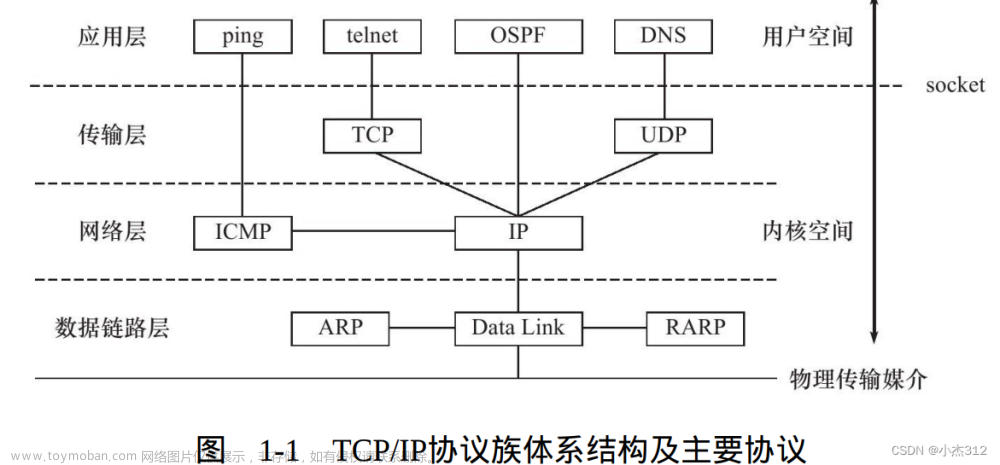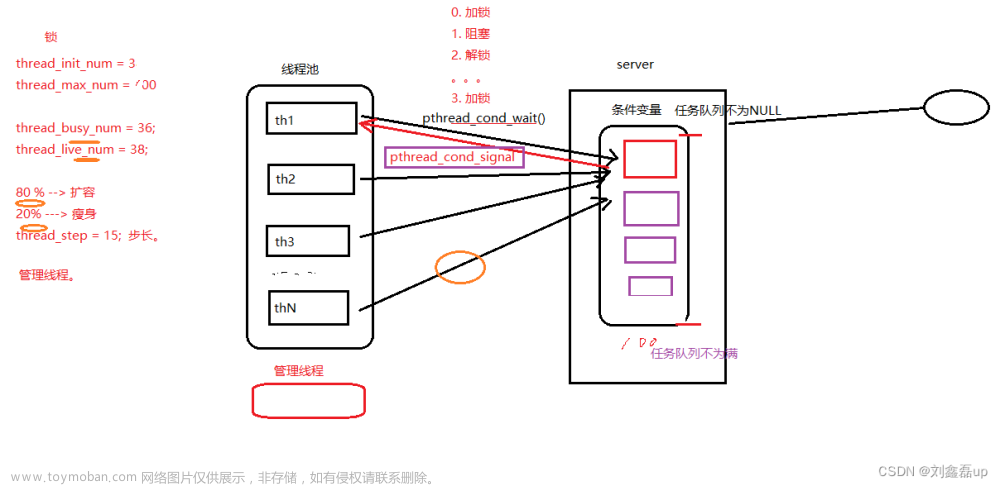目录
一、端口号
二、UDP报头格式
三、UDP的特点
四、UDP协议实现网络聊天群
一、端口号
端口号port标识了一个主机上进行通信的不同的应用程序。
- 0 ~ 1023:系统端口号,HTTP、FTP、SSH等这些广为使用的应用层协议,它们的端口号都是固定的系统端口号(知名端口号)
- 1024 ~ 65535:操作系统动态分配的端口号,客户端程序的端口号,可有操作系统分配或程序员分配(普通端口号)
知名端口号(Well-Know Port Number):
- ftp服务器:21
- ssh服务器:22
- telnet服务器:23
- http服务器:80
- https服务器:443
查看知名端口号:cat /etc/services
netstat:一个用来查看网络状态的重要工具
语法:netstat -[选项]
- n:拒绝显示别名,能显示数字的全部显示数字
- l:仅列出有在 listen 状态的服务状态
- p:显示建立相关连接的程序名
- t:仅显示tcp相关选项
- u:仅显示udp相关选项
- a:显示所有选项,默认不显示 listen 相关
pidof:查看服务器的进程id(通过进程名查看进程id)
语法:pidof [进程名]
端口号 -----> 进程(唯一关系)
- 一个端口号是否可以被多个进程bind?不可以,端口号指向进程必须唯一
- 一个进程是否可以绑定多个端口号?可以,进程指向端口号不一定唯一
二、UDP报头格式

- 16位UDP长度,表示整个数据报(UDP首部+UDP数据)的最大长度(64K)
- 如果检验和出错,数据直接丢弃
- 定长报头,报头的本质是结构化数据

文章来源地址https://www.toymoban.com/news/detail-567965.html
三、UDP的特点
UDP传输的过程类似于寄信:
- 无连接:知道对端的IP和端口号就直接进行传输,不需要建立连接
- 不可靠:没有确认机制,没有重传机制,如果因为网络故障导致数据段无法发送,UDP协议层也不会给应用层返回任何错误信息
- 面向数据报:应用层交给UDP多长的报文,UDP原样发送,既不会拆分,也不会合并,不能够灵活的控制读写数据的次数和数量
UDP的缓冲区:
- UDP没有真正意义上的发送缓冲区,调用sendto会直接交给内核,由内核将数据报传给网络层协议进行后续的传输处理
- UDP具有接收缓冲区,但是这个接收缓冲区不能保证收到的UDP报文的顺序和发送UDP报文的顺序一致;如果缓冲区满了,再到达的UDP数据就会被丢弃
UDP的socket既能读,也能写,这就是全双工概念。
基于UDP的常用应用层协议:
- NFS:网络文件系统
- TFTP:简单的文件传输协议
- DHCP:动态主机配置协议
- BOOTP:启动协议(用于无盘设备启动)
- DNS:域名解析协议
UDP协议的应用场景多为视频网站、直播平台等不担心数据包丢失的情况。
四、UDP协议实现网络聊天群
设计思路:
- 服务器与客户端通过udp协议通信,即server和client都需要创建自己的socket套接字
- server创建完socket套接字之后,需要将server自身的ip和port和套接字bind绑定,client的套接字不需要显式bind绑定(由OS自动绑定)
- server先运行,通过recvfrom()向数据的接收缓冲区循环读取数据
- client在运行的时候指定server的ip和port,通过sendto()向服务器的接收缓冲区发送数据
- User.h头文件,进行在线用户管理,通过ip和port形成用户信息结构体,可以进行在线用户的添加、删除、判断,并且在server接收到数据的时候,进行广播(对所有在线用户发送刚刚接收到的数据)
- 所有在线用户信息通过一个静态全局变量的哈希表管理,key值是ip-port组成的字符串
- client在运行的时候就会进行一次线程分离,分离出去的线程循环读取并打印client自身的接收缓冲区内的数据(来自广播的数据)
设计效果:当多个client连接server之后,只要是online登录了的用户,都可以向server发送数据的同时看到自己和其他登录用户发送的数据,这就是网络聊天群
User.h
#pragma once
#include <iostream>
#include <string>
#include <cstring>
#include <unordered_map>
#include <sys/types.h>
#include <sys/socket.h>
#include <netinet/in.h>
#include <arpa/inet.h>
class User
{
public:
User(const std::string& ip, const uint16_t& port)
: _ip(ip), _port(port)
{}
std::string ip()
{
return _ip;
}
uint16_t port()
{
return _port;
}
private:
std::string _ip;
uint16_t _port;
};
class OnlineUser
{
public:
OnlineUser()
{}
void AddUser(const std::string& ip, const uint16_t& port)
{
std::string id = ip + "-" + std::to_string(port);
_users.insert(std::make_pair(id, User(ip, port)));
}
void DelUser(const std::string& ip, const uint16_t& port)
{
std::string id = ip + "-" + std::to_string(port);
_users.erase(id);
}
bool IsOnline(const std::string& ip, const uint16_t& port)
{
std::string id = ip + "-" + std::to_string(port);
return _users.find(id) != _users.end();
}
void BroadcastMessage(int sockfd, const std::string& message, const std::string& ip, const uint16_t& port)
{
for (auto& user : _users)
{
struct sockaddr_in client;
client.sin_family = AF_INET;
client.sin_addr.s_addr = inet_addr(user.second.ip().c_str());
client.sin_port = htons(user.second.port());
std::string s = "[" + ip + "-" + std::to_string(port) + "]" + "# " + message;
sendto(sockfd, s.c_str(), s.size(), 0, (struct sockaddr*)&client, sizeof(client));
}
}
private:
std::unordered_map<std::string, User> _users;
};server.cpp
#include <iostream>
#include <cstdlib>
#include <string>
#include <cstring>
#include <cerrno>
#include <cassert>
#include <functional>
#include <memory>
#include <unistd.h>
#include <sys/types.h>
#include <sys/socket.h>
#include <netinet/in.h>
#include <arpa/inet.h>
#include "User.h"
using namespace std;
typedef function<void(int, string, uint16_t, string)> func_t;
static string defaultIP = "0.0.0.0";
class UdpServer
{
public:
UdpServer(const func_t& func, const uint16_t& port, const string& ip = defaultIP)
: _cb(func), _port(port), _ip(ip)
{}
void Init()
{
// 1. 创建套接字
_sockfd = socket(AF_INET, SOCK_DGRAM, 0);
if (_sockfd < 0)
{
cerr << "socket error: " << errno << strerror(errno) << endl;
exit(errno);
}
// 2. 绑定 ip:port
struct sockaddr_in local;
local.sin_family = AF_INET;
local.sin_addr.s_addr = htonl(INADDR_ANY); // Address to accept any incomit message -------> 任意地址绑定
// local.sin_addr.s_addr = inet_addr(_ip.c_str()); // string ---> uint32_t ---> htonl
local.sin_port = htons(_port);
int n = bind(_sockfd, (struct sockaddr*)&local, sizeof(local));
if (n < 0)
{
cerr << "bind error: " << errno << strerror(errno) << endl;
exit(errno);
}
}
void Start()
{
char buf[1024];
while (true)
{
struct sockaddr_in peer;
socklen_t peer_len = sizeof(peer);
ssize_t n = recvfrom(_sockfd, buf, sizeof(buf) - 1, 0, (struct sockaddr*)&peer, &peer_len);
if (n > 0)
{
buf[n] = 0;
string client_ip = inet_ntoa(peer.sin_addr); // 网络序列 ---> 整型 ---> 点分十进制
uint16_t client_port = ntohs(peer.sin_port);
string message = buf;
cout << client_ip << "[" << client_port << "]# " << message << endl;
_cb(_sockfd, client_ip, client_port, message);
}
}
}
private:
string _ip;
uint16_t _port;
int _sockfd;
func_t _cb;
};
// 聊天群在线用户,静态全局变量
static OnlineUser g_online_users;
// 处理message,server与业务逻辑解耦
void RouteMessage(int sockfd, string client_ip, uint16_t client_port, string message)
{
if (message == "online")
g_online_users.AddUser(client_ip, client_port);
if (message == "offline")
g_online_users.DelUser(client_ip, client_port);
if (g_online_users.IsOnline(client_ip, client_port))
{
g_online_users.BroadcastMessage(sockfd, message, client_ip, client_port);
}
else
{
struct sockaddr_in client;
bzero(&client, sizeof(client));
client.sin_family = AF_INET;
client.sin_addr.s_addr = inet_addr(client_ip.c_str());
client.sin_port = htons(client_port);
string response = "你还没有登录,请输入online登录加入聊天群";
sendto(sockfd, response.c_str(), response.size(), 0, (struct sockaddr*)&client, sizeof(client));
}
}
void Usage()
{
cout << "Usage: \n\t" << "server port" << endl;
exit(1);
}
int main(int args, char* argv[])
{
if (args != 2)
Usage();
uint16_t port = atoi(argv[1]);
unique_ptr<UdpServer> udp_server(new UdpServer(RouteMessage, port));
udp_server->Init();
udp_server->Start();
return 0;
}client.cpp
#include <iostream>
#include <cstdlib>
#include <string>
#include <cstring>
#include <cerrno>
#include <cassert>
#include <functional>
#include <pthread.h>
#include <memory>
#include <unistd.h>
#include <sys/types.h>
#include <sys/socket.h>
#include <netinet/in.h>
#include <arpa/inet.h>
#include "User.h"
using namespace std;
class UdpClient
{
public:
UdpClient(const string& server_ip, const uint16_t& server_port)
: _server_ip(server_ip), _server_port(server_port), _sockfd(-1), _quit(false)
{}
void Init()
{
// 1. 创建套接字
_sockfd = socket(AF_INET, SOCK_DGRAM, 0);
assert(_sockfd != -1);
cout << "socket seccess: " << _sockfd << endl;
// 2. 绑定bind,不需要显示绑定,由os分配
}
static void* ReadMessage(void* args)
{
int sockfd = *(static_cast<int*>(args));
pthread_detach(pthread_self()); // 线程分离
while (true)
{
char buf[1024];
struct sockaddr_in tmp;
socklen_t tmp_len = sizeof(tmp);
ssize_t n = recvfrom(sockfd, buf, sizeof(buf) - 1, 0, (struct sockaddr*)&tmp, &tmp_len);
if (n >= 0)
buf[n] = 0;
cout << "\r" << buf << "\n";
}
return nullptr;
}
void Run()
{
pthread_create(&_reader, nullptr, ReadMessage, (void*)&_sockfd);
struct sockaddr_in server;
memset(&server, 0, sizeof(server));
server.sin_family = AF_INET;
server.sin_addr.s_addr = inet_addr(_server_ip.c_str());
server.sin_port = htons(_server_port);
string message;
while (!_quit)
{
fprintf(stderr, "Enter:# ");
fflush(stderr);
getline(cin, message);
message[message.size()] = 0;
sendto(_sockfd, message.c_str(), message.size(), 0, (struct sockaddr*)&server, sizeof(server));
usleep(100);
}
}
private:
string _server_ip;
uint16_t _server_port;
int _sockfd;
bool _quit;
pthread_t _reader;
};
void Usage()
{
cout << "Usage: \n\t" << "client ip port" << endl;
}
int main(int args, char* argv[])
{
if (args != 3)
Usage();
string server_ip = argv[1];
uint16_t server_port = atoi(argv[2]);
unique_ptr<UdpClient> udp_client(new UdpClient(server_ip, server_port));
udp_client->Init();
udp_client->Run();
return 0;
}运行效果:
 文章来源:https://www.toymoban.com/news/detail-567965.html
文章来源:https://www.toymoban.com/news/detail-567965.html
到了这里,关于【Linux后端服务器开发】UDP协议的文章就介绍完了。如果您还想了解更多内容,请在右上角搜索TOY模板网以前的文章或继续浏览下面的相关文章,希望大家以后多多支持TOY模板网!







![[网络编程]UDP协议,基于UDP协议的回显服务器](https://imgs.yssmx.com/Uploads/2024/01/814293-1.png)





